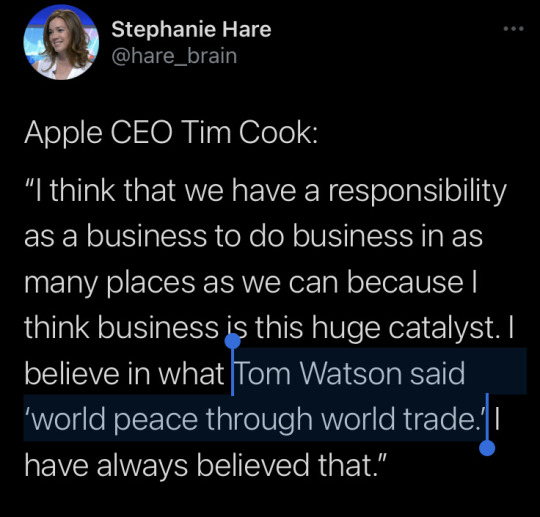Text
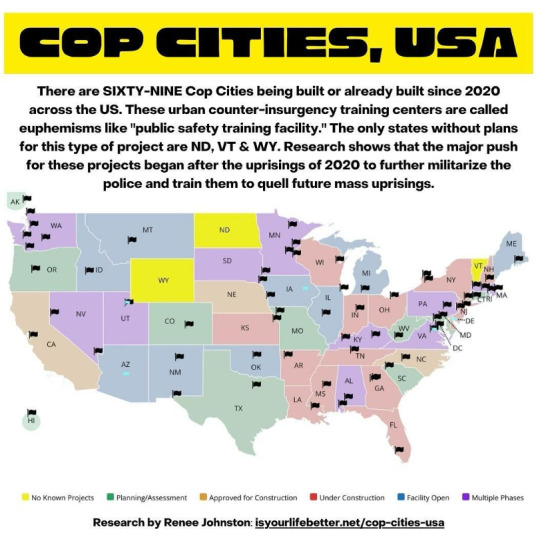
The Stop Cop City movement has sought to prevent the expropriation of part of the Welaunee Forest for the development of an 85-acre police mega training center: a model town to prepare the state’s repressive arms for the urban warfare that will ensue when the contradictions of their exploitation and extraction become uncontainable, as they did in 2020 after the APD murdered Rayshard Brooks.
That murder, and all those that came before, were the lodestars of the Black-led movement during the George Floyd uprisings; their demands were no less than the dismantlement of the entire carceral system. Unable to effectively manage or quell the popular street movements, the Atlanta Police Foundation set out to consolidate and expand their capabilities for surveillance, repression, imprisonment, armed violence, and forced disappearance. One result is Cop City, which has been racked by militant sabotage, land occupation, arson, and popular mobilizations, in an attempt to end the construction and return Atlanta to its people.
As the Atlanta Police Foundation was unable to contain the 2020 Black rebellion, so too have they been unable to quell the resistance against Cop City. The press reports that the project is hemorrhaging money and is mired in delays and difficulties. For their part, the city, the state, and the federal government, have in turn employed every tool in their power to destroy the movement. Last week, the Georgia State Senate passed a bill to effectively criminalize bail funds in the state; RICO charges have been contorted to target networks of support and care that surround the fighters; and last January, APD assassinated the comrade Tortuguita in cold blood while they rested in their tent in the forest. It is clear that Stop Cop City represents one of the conjunctural spear tips for expanding the existing systems of counterinsurgency that span Africa, Asia, and the Arab world.
Today the system’s belly rests atop Gaza, whose rumblings shake the earth upon which we walk. Through its Georgia International Law Enforcement Exchange (GILEE) program, the APD has sent hundreds of police to train with the Zionist occupation forces. And in October 2023, after Tufan al-Aqsa, the Atlanta Police Department engaged in hostage training inside abandoned hotels, putatively intended to “defeat Hamas,” in an advancement of tactics for the targeting of Black people.
With every such expansion, the ability of counterinsurgency doctrines to counteract people’s liberation struggles grows. The purpose of counterinsurgency is to marshal state and para-state power into political, social, economic, psychological, and military warfare to overwhelm both militants and the popular cradle—the people—who support them. Its aim is to render us hopeless; to isolate and dispossess us and to break our will to resist it by any and all means necessary. This will continue apace, unless we fight to end it.
Stop Cop City remains undeterred: on Friday, an APD cop car was burnt overnight in response to the police operation on February 8; yesterday, two trucks and trailers loaded with lumber were burnt to the ground. An anonymous statement claiming credit for the former, stated: “We wish to dispel any notion that people will take this latest wave of repression lying down, or that arresting alleged arsonists will deter future arsons.”
As the U.S. government and Zionist entity set their sights on the Palestinian people sheltering in Rafah, as they continue their relentless genocide of our people in Khan Younis, Jabalia, Shuja’iyya, and Gaza City, the Stop Cop City movement has clearly articulated its solidarity with the Palestinian struggle. They have done so with consistency and discipline, and we have heard them. Our vision of freedom in this life and the next requires us to confront and challenge the entangled forces of oppression in Palestine and in Turtle Island, and to identify the sites of tension upon which these systems distill their forces. This week, as with the last three years, the forest defenders have presented us one such crucible.
(11 Feb 24)
National Lawyers Guild, Stop All Cop Cities: Lessons For a National Struggle (video, 1 hr 45 min)
1K notes
·
View notes
Text

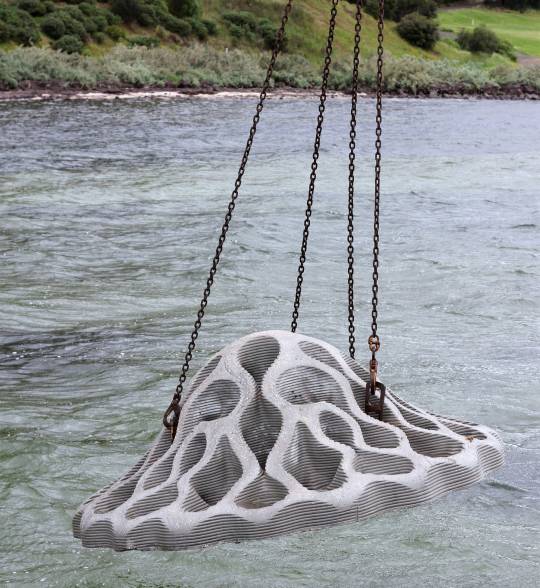

Barriers Made of Concrete and Oyster Shells Mitigate Erosion and Offer Alluring New Habitats on Australia’s Coastline
6K notes
·
View notes
Text
Earlier this week the trade union for doctors and medical students in the UK issued a warning about the number of doctors that have had to quit or reduce their hours due to long covid – the number was one in five.
This story was covered in a limited way in a couple of places, which while not good enough was still a welcome jolt of covid reality in a landscape of denial.
But tellingly, the media ignored something else the British Medical Association said. Something angry, something as equally demanding of attention, perhaps even more so than the headline statistic.
Addressing the current spread of covid, particularly in healthcare settings, they said, “Infection control guidelines are fundamentally flawed: SARS-CoV-2 is airborne. It is outrageous that three-and-a-half years into this pandemic, staff and patients are still, knowingly and repeatedly, being exposed to a level-3 biohazard – a virus known to cause brain damage and significantly increased risk of life-threatening blood complications even in those recovered.”
The union entrusted by 173,000 doctors and medical students in the UK to speak on their behalf is angrily castigating politicians and decision makers for refusing to face reality. The reality of covid as an airborne virus, and its reality as something much nastier than a cold or flu. They are demanding the reintroduction of infectious disease controls, and explicitly calling out covid as a brain damaging virus, and equivalent in its danger and infectiousness to yellow fever or West Nile virus.
903 notes
·
View notes
Text
For years, the people of the Kitasoo/Xai’xais First Nation watched over their waters and waited. They had spent nearly two decades working with Canada’s federal government to negotiate protections for Kitasu Bay, an area off the coast of British Columbia that was vulnerable to overfishing.
But the discussions never seemed to go anywhere. First, they broke down over pushback from the fishing industry, then over a planned oil tanker route directly through Kitasoo/Xai’xais waters.
“We were getting really frustrated with the federal government. They kept jumping onboard and then pulling out,” says Douglas Neasloss, the chief councillor and resource stewardship director of the Kitasoo/Xai’xais First Nation. “Meanwhile, we’d been involved in marine planning for 20 years – and we still had no protected areas.”
Instead, the nation watched as commercial overfishing decimated the fish populations its people had relied on for thousands of years.
Nestled on the west coast of Swindle Island, approximately 500km north of Vancouver, Kitasu Bay is home to a rich array of marine life: urchins and abalone populate the intertidal pools, salmon swim in the streams and halibut take shelter in the deep waters. In March, herring return to spawn in the eelgrass meadows and kelp forests, nourishing humpback whales, eagles, wolves and bears.
“Kitasu Bay is the most important area for the community – that’s where we get all of our food,” Neasloss says. “It’s one of the last areas where you still get a decent spawn of herring.”
So in December 2021, when the Department of Fisheries and Oceans withdrew from discussions once again, the nation decided to act. “My community basically said, ‘We’re tired of waiting. Let’s take it upon ourselves to do something about it,’” Neasloss says.
What they did was unilaterally declare the creation of a new marine protected area (MPA). In June 2022, the nation set aside 33.5 sq km near Laredo Sound as the new Gitdisdzu Lugyeks (Kitasu Bay) MPA – closing the waters of the bay to commercial and sport fishing.
It is a largely unprecedented move. While other marine protected areas in Canada fall under the protection of the federal government through the Oceans Act, Kitasu Bay is the first to be declared under Indigenous law, under the jurisdiction and authority of the Kitasoo/Xai’xais First Nation.

Pictured: "In some ways, I hope someone challenges us" … the Kitasoo/Xai’xais stewardship authority.
Although they did not wait for government approval, the Kitasoo did consult extensively: the declaration was accompanied by a draft management plan, finalised in October after three months of consultation with industry and community stakeholders. But the government did not provide feedback during that period, according to Neasloss, beyond an acknowledgment that it had received the plan...
Approximately 95% of British Columbia is unceded: most First Nations in the province of British Columbia never signed treaties giving up ownership of their lands and waters to the crown. This puts them in a unique position to assert their rights and title, according to Neasloss, who hopes other First Nations will be inspired to take a similarly proactive approach to conservation...
Collaboration remains the goal, and Neasloss points to a landmark agreement between the Haida nation and the government in 1988 to partner in conserving the Gwaii Haanas archipelago, despite both parties asserting their sovereignty over it. A similar deal was made in 2010 for the region’s 3,400 sq km Gwaii Haanas national marine conservation area.
“They found a way to work together, which is pretty exciting,” says Neasloss. “And I think there may be more Indigenous protected areas that are overlaid with something else.”
-via The Guardian, 5/3/23
11K notes
·
View notes
Link
Americans support recycling. We do too. But although some materials can be effectively recycled and safely made from recycled content, plastics cannot. Plastic recycling does not work and will never work. The United States in 2021 had a dismal recycling rate of about 5 percent for post-consumer plastic waste, down from a high of 9.5 percent in 2014, when the U.S. exported millions of tons of plastic waste to China and counted it as recycled—even though much of it wasn’t.
Recycling in general can be an effective way to reclaim natural material resources. The U.S.’s high recycling rate of paper, 68 percent, proves this point. The problem with recycling plastic lies not with the concept or process but with the material itself.
The first problem is that there are thousands of different plastics, each with its own composition and characteristics. They all include different chemical additives and colorants that cannot be recycled together, making it impossible to sort the trillions of pieces of plastics into separate types for processing. For example, polyethylene terephthalate (PET#1) bottles cannot be recycled with PET#1 clamshells, which are a different PET#1 material, and green PET#1 bottles cannot be recycled with clear PET#1 bottles (which is why South Korea has outlawed colored PET#1 bottles.) High-density polyethylene (HDPE#2), polyvinyl chloride (PVC#3), low-density polyethylene (LDPE#4), polypropylene (PP#5), and polystyrene (PS#6) all must be separated for recycling.
Just one fast-food meal can involve many different types of single-use plastic, including PET#1, HDPE#2, LDPE#4, PP#5, and PS#6 cups, lids, clamshells, trays, bags, and cutlery, which cannot be recycled together. This is one of several reasons why plastic fast-food service items cannot be legitimately claimed as recyclable in the U.S.
Another problem is that the reprocessing of plastic waste—when possible at all—is wasteful. Plastic is flammable, and the risk of fires at plastic-recycling facilities affects neighboring communities—many of which are located in low-income communities or communities of color.
Unlike metal and glass, plastics are not inert. Plastic products can include toxic additives and absorb chemicals, and are generally collected in curbside bins filled with possibly dangerous materials such as plastic pesticide containers. According to a report published by the Canadian government, toxicity risks in recycled plastic prohibit “the vast majority of plastic products and packaging produced” from being recycled into food-grade packaging.
Yet another problem is that plastic recycling is simply not economical. Recycled plastic costs more than new plastic because collecting, sorting, transporting, and reprocessing plastic waste is exorbitantly expensive. The petrochemical industry is rapidly expanding, which will further lower the cost of new plastic.
Despite this stark failure, the plastics industry has waged a decades-long campaign to perpetuate the myth that the material is recyclable. This campaign is reminiscent of the tobacco industry’s efforts to convince smokers that filtered cigarettes are healthier than unfiltered cigarettes.
7K notes
·
View notes
Text
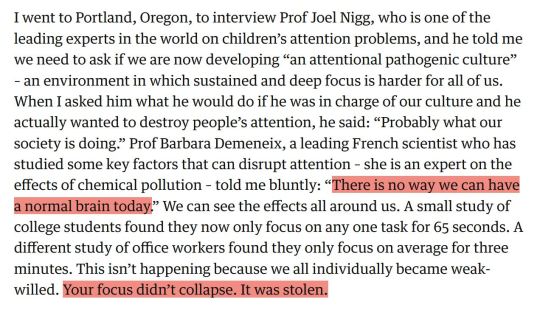
Your attention didn’t collapse. It was stolen by Johann Hari
57K notes
·
View notes
Text
a tiny problem
this probably hasn't made the news in other countries - huge mining company Rio Tinto managed to lose this little capsule (8 x 6 mm) somewhere in West Australia:

it's caesium-137, the stuff that has made Chernobyl uninhabitable, and you don't want to be standing within 5-10 meters of it, because it's blasting out beta and gamma rays. you REALLY don't want to pick it up, because it'll give you radiation burns.
what's nuts is it seems to have somehow escaped from its "secure" container and fallen out of a bolt hole while being transported, and then nobody noticed for TWO WEEKS.
anyway there are fire fighters on their sixth day of scouring 1,400 km (!) of desert road right now, but it's so small that it may never be found (I think the detection radius with the equipment they're using is maybe 20m). it's so small that it could have stuck in a car's tire treads, or been picked up by an unfortunate bird or other wildlife. it has a half-life of 30 years, which means it'll be dangerously radioactive for centuries.
it's just an incredible fuckup on so many levels.
44K notes
·
View notes
Link
Amazon is facing a looming crisis: It could run out of people to hire in its US warehouses by 2024, according to leaked Amazon internal research from mid-2021 that Recode reviewed. If that happens, the online retailer’s service quality and growth plans could be at risk, and its e-commerce dominance along with it.
Raising wages and increasing warehouse automation are two of the six “levers” Amazon could pull to delay this labor crisis by a few years, but only a series of sweeping changes to how the company does business and manages its employees will significantly alter the timeline, Amazon staff predicted. […]
In the Inland Empire region of California, for example, Amazon may cycle through every worker who’d be interested in applying for a warehouse job by the end of 2022, the internal report warned. One of the reasons is that Amazon is increasingly finding itself in a bidding war for workers with rivals in the area, which is a key logistics region because it is within a two-hour drive of 20 million potential customers and two of the largest container ports in the US.
“We are hearing a lot of [Amazon] workers say, ‘I can just go across the street to Target or Walmart,’” said Sheheryar Kaoosji, co-executive director of an Inland Empire nonprofit called the Warehouse Worker Resource Center. Kaoosji added that Walmart is offering some workers with past warehouse experience as much as $25 an hour. An Amazon executive told Reuters in late 2021 that the company was bumping the average starting wage for new hires in the US to more than $18 an hour, attributing the decision to intense competition among employers. He also said Amazon had increased hiring bonuses to as much as $3,000 in some geographies.
And internal forecasts showed the situation was dire in Phoenix, Arizona, with Amazon projected to exhaust its entire potential workforce by the end of 2021. The Phoenix metro area has been a key market for Amazon since it opened its first warehouse there in 2007. The company currently operates more than 20 facilities in the region. But attrition at Amazon’s facilities in the area grew from 128 percent in 2019 to 205 percent in 2020, as the pandemic upended labor markets and online shopping boomed, putting pressure on fulfillment center employees.
As a result, Amazon seemed to have reversed, or stopped enforcing, some workplace policies at Phoenix warehouses amid the labor shortage, according to a former manager.
“They were so concerned about attrition and losing people that they rolled back all the policies that us as managers had to enforce,” Michael Garrigan, a former entry-level manager at Amazon warehouses in Phoenix from 2020 to early 2022, told Recode. “There was a joke among the … managers that it didn’t matter what [workers] got written up for because we knew HR was gonna exempt it. It was almost impossible to get fired as a worker.”

6K notes
·
View notes
Text
"Don't spy on a privacy lab" (and other career advice for university provosts)

This is a wild and hopeful story: grad students at Northeastern successfully pushed back against invasive digital surveillance in their workplace, through solidarity, fearlessness, and the bright light of publicity. It’s a tale of hand-to-hand, victorious combat with the “shitty technology adoption curve.”
What’s the “shitty tech adoption curve?” It’s the process by which oppressive technologies are normalized and spread. If you want to do something awful with tech — say, spy on people with a camera 24/7 — you need to start with the people who have the least social capital, the people whose objections are easily silenced or overridden.
That’s why all our worst technologies are first imposed on refugees -> prisoners -> kids -> mental patients -> poor people, etc. Then, these technologies climb the privilege gradient: blue collar workers -> white collar workers -> everyone. Following this pathway lets shitty tech peddlers knock the rough edges off their wares, inuring us all to their shock and offense.
https://pluralistic.net/2022/08/21/great-taylors-ghost/#solidarity-or-bust
20 years ago, if you ate dinner under the unblinking eye of a CCTV, it was because you were housed in a supermax prison. Today, it’s because you were unwise enough to pay hundreds or thousands of dollars for “home automation” from Google, Apple, Amazon or another “luxury surveillance” vendor.
Northeastern’s Interdisciplinary Science and Engineering Complex (ISEC) is home to the “Cybersecurity and Privacy Institute,” where grad students study the harms of surveillance and the means by which they may be reversed. If there’s one group of people who are prepared to stand athwart the shitty tech adoption curve, it is the CPI grad students.
Which makes it genuinely baffling that Northeastern’s Senior Vice Provost for Research decided to install under-desk heat sensors throughout ISEC, overnight, without notice or consultation. The provost signed the paperwork that brought the privacy institute into being.
Students throughout ISEC were alarmed by this move, but especially students on the sixth floor, home to the Privacy Institute. When they demanded an explanation, they were told that the university was conducting a study on “desk usage.” This rang hollow: students at the Privacy Institute have assigned desks, and they badge into each room when they enter it.
As Privacy Institute PhD candidate Max von Hippel wrote, “Reader, we have assigned desks, and we use a key-card to get into the room, so, they already know how and when we use our desks.”
https://twitter.com/maxvonhippel/status/1578048837746204672
So why was the university suddenly so interested in gathering fine-grained data on desk usage? I asked von Hippel and he told me: “They are proposing that grad students share desks, taking turns with a scheduling web-app, so administrators can take over some of the space currently used by grad students. Because as you know, research always works best when you have to schedule your thinking time.”
That’s von Hippel’s theory, and I’m going to go with it, because the provost didn’t offer a better one in the flurry of memos and “listening sessions” that took place after the ISEC students arrived at work one morning to discover sensors under their desks.
This is documented in often hilarious detail in von Hippel’s thread on the scandal, in which the university administrators commit a series of unforced errors and the grad students run circles around them, in a comedy of errors straight out of “Animal House.”
https://twitter.com/maxvonhippel/status/1578048652215431168
After the sensors were discovered, the students wrote to the administrators demanding their removal, on the grounds that there was no scientific purpose for them, that they intimidated students, that they were unnecessary, and that the university had failed to follow its own rules and ask the Institutional Review Board (IRB) to review the move as a human-subjects experiment.
The letter was delivered to the provost, who offered “an impromptu listening session” in which he alienated students by saying that if they trusted the university to “give” them a degree, they should trust it to surveil them. The students bristled at this characterization, noting that students deliver research (and grant money) to “make it tick.”
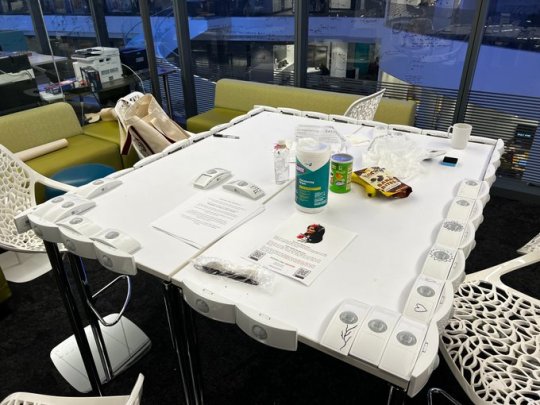
[Image ID: Sensors arrayed around a kitchen table at ISEC]
The students, believing the provost was not taking them seriously, unilaterally removed all the sensors, and stuck them to their kitchen table, annotating and decorating them with Sharpie. This prompted a second, scheduled “listening session” with the provost, but this session, while open to all students, was only announced to their professors (“Beware of the leopard”).
The students got wind of this, printed up fliers and made sure everyone knew about it. The meeting was packed. The provost explained to students that he didn’t need IRB approval for his sensors because they weren’t “monitoring people.” A student countered, what was being monitored, “if not people?” The provost replied that he was monitoring “heat sources.”
https://github.com/maxvonhippel/isec-sensors-scandal/blob/main/Oct_6_2022_Luzzi_town_hall.pdf
Remember, these are grad students. They asked the obvious question: which heat sources are under desks, if not humans (von Hippel: “rats or kangaroos?”). The provost fumbled for a while (“a service animal or something”) before admitting, “I guess, yeah, it’s a human.”
Having yielded the point, the provost pivoted, insisting that there was no privacy interest in the data, because “no individual data goes back to the server.” But these aren’t just grad students — they’re grad students who specialize in digital privacy. Few people on earth are better equipped to understand re-identification and de-aggregation attacks.
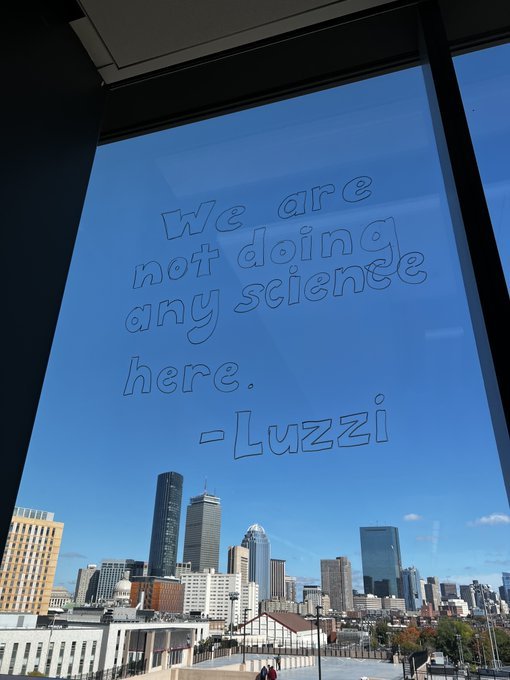
[Image ID: A window with a phrase written in marker, ‘We are not doing science here’ -Luzzi.]
A student told the provost, “This doesn’t matter. You are monitoring us, and collecting data for science.” The provost shot back, “we are not doing science here.” This ill-considered remark turned into an on-campus meme. I’m sure it was just blurted in the heat of the moment, but wow, was that the wrong thing to tell a bunch of angry scientists.
From the transcript, it’s clear that this is where the provost lost the crowd. He accused the students of “feeling emotion” and explaining that the data would be used for “different kinds of research. We want to see how students move around the lab.”
Now, as it happens, ISEC has an IoT lab where they take these kinds of measurements. When they do those experiments, students are required to go through IRB, get informed consent, all the stuff that the provost had bypassed. When this is pointed out, the provost says that they had been given an IRB waiver by the university’s Human Research Protection Program (HRPP).
Now a prof gets in on the action, asking, pointedly: “Is the only reason it doesn’t fall under IRB is that the data will not be published?” A student followed up by asking how the university could justify blowing $50,000 on surveillance gear when that money would have paid for a whole grad student stipend with money left over.
The provost’s answers veer into the surreal here. He points out that if he had to hire someone to monitor the students’ use of their desks, it would cost more than $50k, implying that the bill for the sensors represents a cost-savings. A student replies with the obvious rejoinder — just don’t monitor desk usage, then.
Finally, the provost started to hint at the underlying rationale for the sensors, discussing the cost of the facility to the university and dangling the possibility of improving utilization of “research assets.” A student replies, “If you want to understand how research is done, don’t piss off everyone in this building.”
Now that they have at least a vague explanation for what research question the provost is trying to answer, the students tear into his study design, explaining why he won’t learn what he’s hoping to learn. It’s really quite a good experimental design critique — these are good students! Within a few volleys, they’re pointing out how these sensors could be used to stalk researchers and put them in physical danger.
The provost turns the session over to an outside expert via a buggy Zoom connection that didn’t work. Finally, a student asks whether it’s possible that this meeting could lead to them having a desk without a sensor under it. The provost points out that their desk currently doesn’t have a sensor (remember, the students ripped them out). The student says, “I assume you’ll put one back.”
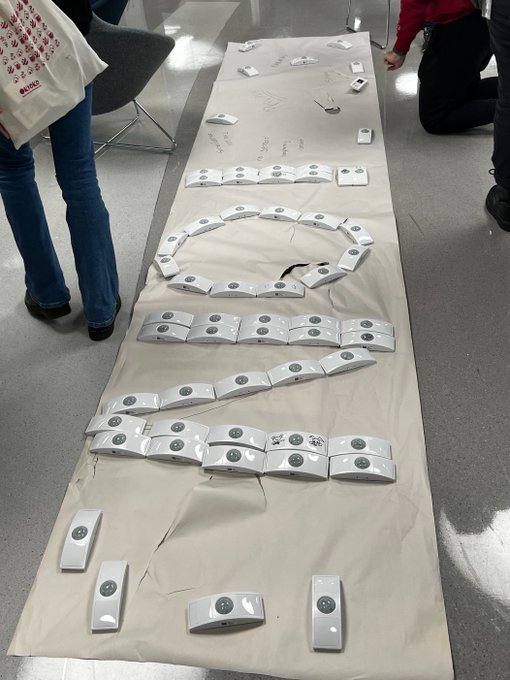
[Image ID: A ‘public art piece’ in the ISEC lobby — a table covered in sensors spelling out ‘NO!,’ surrounded by Sharpie annotations decrying the program.]
They run out of time and the meeting breaks up. Following this, the students arrange the sensors into a “public art piece” in the lobby — a table covered in sensors spelling out “NO!,” surrounded by Sharpie annotations decrying the program.
Meanwhile, students are still furious. It’s not just that the sensors are invasive, nor that they are scientifically incoherent, nor that they cost more than a year’s salary — they also emit lots of RF noise that interferes with the students’ own research. The discussion spills onto Reddit:
https://www.reddit.com/r/NEU/comments/xx7d7p/northeastern_graduate_students_privacy_is_being/
Yesterday, the provost capitulated, circulating a memo saying they would pull “all the desk occupancy sensors from the building,” due to “concerns voiced by a population of graduate students.”
https://twitter.com/maxvonhippel/status/1578101964960776192
The shitty technology adoption curve is relentless, but you can’t skip a step! Jumping straight to grad students (in a privacy lab) without first normalizing them by sticking them on the desks of poor kids in underfunded schools (perhaps after first laying off a computer science teacher to free up the budget!) was a huge tactical error.
A more tactically sound version of this is currently unfolding at CMU Computer Science, where grad students have found their offices bugged with sensors that detect movement and collect sound:
https://twitter.com/davidthewid/status/1387909329710366721
The CMU administration has wisely blamed the presence of these devices on the need to discipline low-waged cleaning staff by checking whether they’re really vacuuming the offices.
https://twitter.com/davidthewid/status/1387426812972646403
While it’s easier to put cleaners under digital surveillance than computer scientists, trying to do both at once is definitely a boss-level challenge. You might run into a scholar like David Gray Widder, who, observing that “this seems like algorithmic management of lowly paid employees to me,” unplugged the sensor in his office.
https://twitter.com/davidthewid/status/1387909329710366721
This is the kind of full-stack Luddism this present moment needs. These researchers aren’t opposed to sensors — they’re challenging the social relations of sensors, who gets sensed and who does the sensing.
https://locusmag.com/2022/01/cory-doctorow-science-fiction-is-a-luddite-literature/
[Image ID: A flier inviting ISEC grad students to attend an unadvertised ‘listening session’ with the vice-provost. It is surmounted with a sensor that has been removed from beneath a desk and annotated in Sharpie to read: ‘If found by David Luzzi suck it.’]
41K notes
·
View notes
Text


i wish all gas and electricity firms a very happy die
77K notes
·
View notes
Link
Amazon plans to block and flag employee posts on an internal messaging app that contain keywords pertaining to labor unions, according to internal company documents reviewed by The Intercept. An automatic word monitor would also block a variety of terms that could represent potential critiques of Amazon’s working conditions, like “slave labor,” “prison,” and “plantation,” as well as “restrooms” — presumably related to reports of Amazon employees relieving themselves in bottles to meet punishing quotas.
6K notes
·
View notes
Text
March 24, 2022. Not particularly surprising, but...
Link to the journal article in Environment International.
From the Guardian piece:
Microplastic pollution has been detected in human blood for the first time, with scientists finding the tiny particles in almost 80% of the people tested.
The discovery shows the particles can travel around the body and may lodge in organs. The impact on health is as yet unknown. But researchers are concerned as microplastics cause damage to human cells in the laboratory and air pollution particles are already known to enter the body and cause millions of early deaths a year.
Huge amounts of plastic waste are dumped in the environment and microplastics now contaminate the entire planet, from the summit of Mount Everest to the deepest oceans. People were already known to consume the tiny particles via food and water as well as breathing them in, and they have been found in the faeces of babies and adults.
The scientists analysed blood samples from 22 anonymous donors, all healthy adults and found plastic particles in 17. Half the samples contained PET plastic, which is commonly used in drinks bottles, while a third contained polystyrene, used for packaging food and other products. A quarter of the blood samples contained polyethylene, from which plastic carrier bags are made.
“Our study is the first indication that we have polymer particles in our blood – it’s a breakthrough result,” said Prof Dick Vethaak, an ecotoxicologist at Vrije Universiteit Amsterdam in the Netherlands. “But we have to extend the research and increase the sample sizes, the number of polymers assessed, etc.” Further studies by a number of groups are already under way, he said.
9K notes
·
View notes
Text
- Antarctic now at 90-degrees-Fahrenheit above normal.
- Melting at both South and North poles, simultaneously, shouldn’t happen because they’re in opposite seasons.
Italicized quotes from Brett Wilkins’s article for Common Dreams, 20 March 2022:
- ‘Stefano Di Battista, an Antarctic climatologist, tweeted that such record-shattering heat near the South Pole was “unthinkable” and “impossible […]. Antarctic climatology has been rewritten.”‘
- ‘Jonathan Wille, a researcher studying polar meteorology at Universite Grenoble Alpes in France, told The Washington Post that “this event is completely unprecedented and upended our expectations about the Antarctic climate system […]. This is when temperatures should be rapidly falling since the summer solstice in December,” Wille tweeted. “This is Pacific Northwest 2021 heatwave kind of event. […] Never supposed to happen.”’
- ‘Walt Meier, a senior research scientist at the National Snow and Ice Data Center in Boulder, Colorado, told USA Today that “you don’t see the North and the South [poles] both melting at the same time” because “they are opposite seasons.“’
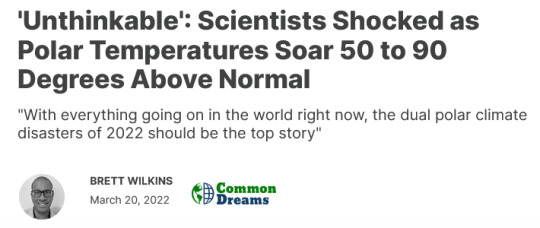
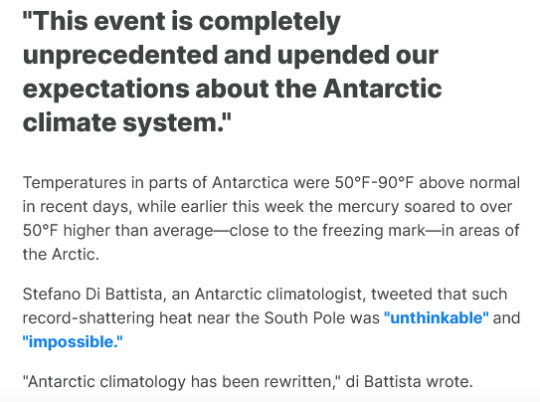

2K notes
·
View notes
Link
In an accident of geography and history, Romania is home to one of the largest and most important old-growth forests left in the world. Its Carpathian mountain chain, which wraps like a seat belt across the country’s middle and upper shoulder, hosts at least half of Europe’s remaining old growth outside Scandinavia and around 70 percent of the continent’s virgin forest. It’s been referred to as the Amazon of Europe, a comparison apt and ominous in equal measure, because of the speed at which it, like the Amazon itself, is disappearing.
Most of Europe was rapidly deforested during the industrial era; less than 4 percent of EU forestland remains intact. Romania, far enough from the continent’s industrial centers and long a closed-off member of the Soviet bloc, remained a shining exception. During the country’s communist period, the government converted the forests to public ownership and kept them off global export markets, enshrining the forest management trends of an ancien regime. The result is that Romania retains some of the rare spruce, beech, and oak forests that qualify as old- or primary-growth, having never been excessively logged, altered by human activity, or artificially replanted.
But the fall of communism in 1989 dissolved one layer of protection for those forests, and the subsequent wave of privatization inaugurated widespread corruption. In 2007, Romania’s entry to the European Union created a massive, liberated market for the country’s cheap, abundant timber and the inexpensive labor required to extract it, conditions that encouraged Austrian timber companies and Swedish furniture firms to set up shop. Succeeding fractious, ineffectual regimes enacted further pro-market reforms and did little to curb corruption; in the final months of 2021, the country’s prime minister designate found himself unable to form a government at all. Add to that the astronomical growth of the fast furniture industry, which particularly relies on the spruce and beech that populate these forests, and the result has been a delirium of deforestation.
There’s one obvious, notable beneficiary of this situation: Ikea. The company is now the largest individual consumer of wood in the world, its appetite growing by two million trees a year. According to some estimates, it sources up to 10 percent of its wood from the relatively small country of Romania, and has long enjoyed relationships with mills and manufacturers in the region. In 2015, it began buying up forestland in bulk; within months it became, and remains, Romania’s largest private landowner.
[…] Without even accounting for possible violations based on method of extraction, more than half of the country’s timber is illegally harvested. Even legal logging, which on private and public land alike must be preceded by a forest management plan that is approved by the government, can be rife with corruption and abuse. Since roughly the date of Romania’s accession to the EU, between half and two-thirds of the country’s virgin forest has been lost.
623 notes
·
View notes

